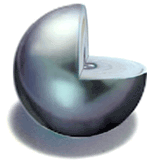If you're getting ready to buy pearls, it's important that you know what you're getting yourself into, so that you can recognize a deal when you see one. Price and quality are not as simple as shape or size, or even color.
There are 7 main factors to keep in mind when determining a pearl's quality and worth: Type, Nacre, Luster, Surface, Shape, Color and Size.
- Type of Pearl
- Nacre
- Luster
- Surface
- Shape
- Color
- Size
Type of Pearl
|
The first step is to identify the type of pearl: Freshwater, Akoya, Tahitian or South Sea, the four main pearl types used in jewelry. Each type of pearl is produced by a different species of mollusk (pearl oyster), and each mollusk lives in a different region of the world under very specific climatic conditions. See: Pearl Types for more details. |
|
Nacre
|
Nacre is the substance an oyster creates to cover an irritant within the shell such as shell fragments, parasites or implanted beads. Nacre is multiple layers of calcium carbonate crystals and this is the same beautiful iridescent material that lines the inner surface of the mollusk shells, aptly named mother of pearl. Generally, the thicker the nacre, the more the pearl is worth. Nacre thickness is a quality characteristic only applied to saltwater, bead-nucleated pearls. It is not applied to keshi pearls or freshwater pearls as both are composed of solid nacre. |
 |
Luster
|
Luster is the intense glow that comes from within the pearl, it is produced by light entering the pearl and reflecting back through the layers of nacre. The luster of good quality pearls is sharp and bright. You should be able to see your reflection on the surface of a pearl with good luster. A pearl with no reflection or a dull color is of poorer quality. Usually, saltwater pearls are more lustrous than the freshwater variety. |
|
Surface
|
No two pearls are alike, and one of the factors that makes each different is its surface quality. Virtually no pearl is perfect, and any flawless specimens are treasures. The cleaner the surface of the pearl, the more valuable it is. Look for an absence of disfiguring spots, bumps or cracks on the surface of a pearl, also known as "cleanliness." Notice that the highest quality pearls have a sharp, mirror-like reflection. |
|
Shape
|
A perfectly round pearl is very rare. The rounder the pearl, the more valuable it is. Baroque pearls are not symmetrical in shape, and can be lustrous and appealing, but will typically cost less than round pearls. There are many exotic shapes including 'off-round', 'circle', 'ringed', 'potato', and 'pear'. The most common shapes are shown at right. |
 |
Color
|
Unlike the other factors, color has little influence on the actual value of a pearl, except in the case of popularity. Essentially, the color of the pearl you desire is a matter of personal taste. Traditionally, there is a rather consistent demand for the classic silvery white pearls and the glowing gold shades. The rarest and most desired are the white �rose� colored pearls.
|
|
Size
|
Pearl size is measured in carats for natural pearls and by their diameter in millimeters for cultured pearls. For most pearls, if all other quality factors are the same, the larger it is, the more expensive. Pearls can range in size from 1mm seed pearls to huge 20mm South Sea pearls. Cultured pearls of 6 - 7.5mm are the most common, above this size the price jumps upward rapidly with each half-millimeter from 7.5mm up. To date the largest pearl recorded is a 26.95mm baroque south sea pearl. |
 |

















